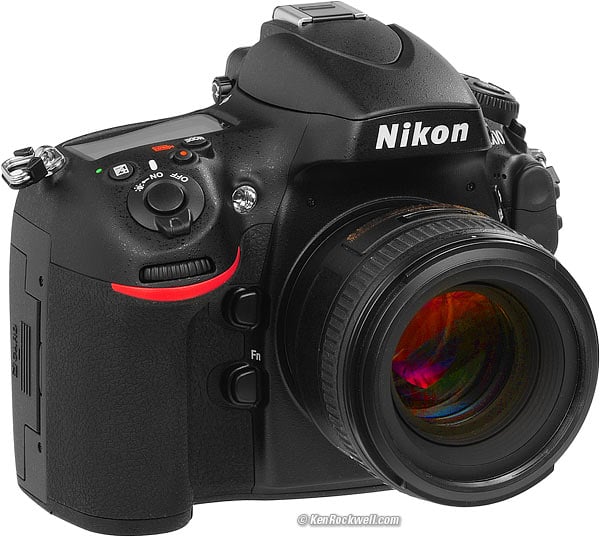Home Donate New Search Gallery Reviews How-To Books Links Workshops About Contact
Nikon
D800 and D800E User's Guide:
Custom Setting Menu: Metering/exposure
© 2012 KenRockwell.com. All rights reserved.

Nikon D800 and 50mm f/1.4 G. enlarge.
July 2012 D800 and D800E Review Nikon Reviews Nikon Lenses All Reviews
Top of D800 and D800E User's Guide
Help me help you top
I support my growing family through this free website. The biggest help is when you use any of these links when you get anything, regardless of the country in which you live.
If you find this page as helpful as a book you might have had to buy or a workshop you may have had to take, feel free to help me continue helping everyone.
While free to read online, this page is formally registered and copyrighted, so it is unlawful to make copies, especially in the form of printouts for personal use or saving these pages or files. If you wish to make a printout for personal use, you are granted one-time permission to print from your browser (there is no PDF) only if you PayPal me $5.00 per printout, file save, or part thereof, unless of course you bought your D800 through one of my links. This is how I justify spending weeks away from my family writing and sharing all this for free online.
Thank you and thanks for your support!
Custom Settings
Menu:
Metering/exposure
Want free live phone support? In the USA, call (800) NIKON-UX, 24 hours a day, 365 days a year.
b1 - b6 Metering/exposure
How to Get Here
Press MENU, go to the left and select up and down to the pencil icon.
You'll then see CUSTOM SETTING MENU on the color LCD.
Click down to b METERING/EXPOSURE and click to the right.
What it Does
Here we set light metering options.
What I Change
I change b1 and b2. I leave the rest alone.
b1 ISO sensitivity step value top
This defaults to 1/3 stops. That's silly.
I set mine to change the ISO in full stops. I shoot at 100, 200, 400, 800, 1,600 or 3,200 and don't waste time in-between. By not bothering with the in-between thirds I can select my ISOs with fewer clicks.
There's one catch: a firmware defect in the D800 and D800E make the in-finder exposure compensation bar graph follow this setting, instead of following the setting for b3 Exposure compensation units.
Therefore, set to 1 stop for ISO changes, my finder's compensation bar graph only reads in half stops, and fails to display if I have compensation set to ±0.3 stops.
b2 EV steps for exposure control top
This defaults to 1/3 stops. I don't use this, except in manual exposure.
In the Auto modes I set it to full (1) stops. This lets me make my settings faster, since they take fewer clicks. Depth of field or motion control doesn't need more precision than a full stop.
Even though the D800 and D800E set exposure steplessly, finder and EXIF readout of apertures and shutter speeds in auto modes is rounded to the nearest full stop. I prefer this; I have enough to worry about without having to do mental gymnastics to realize that f/6.3 is the same as f/5.6 for all intents and purposes.
Design Flaw: Ideally Nikon would provide separate settings for manual and auto exposure. I'd set 1/3 stops for manual exposure and full stops in auto exposure (P, S and A modes). You need the precision in manual mode, but not in the auto modes, because the values chosen by the D800 and D800E are set steplessly regardless of how they are displayed.
b3 Exp./flash comp. step value top
Leave this at 1/3.
It's silly to fine tune in full stops, they are too coarse.
I tune in thirds.
b4 Easy exposure compensation top
This lets you alter your exposure by turning the front dial without having to press the Exposure Compensation (lighten/darken) button.
I love "Easy," which is the name of this feature, but it's too easy. I hit the dial too often by accident, so I don't use it. I leave it at its default of OFF.
b5 Center-weighted area top
This sets the diameter of the sensitive part of the center weighted meter. These settings only take effect when you've selected center weighted metering.
I never use center weighted metering, so I certainly never play with this.
You also have the option of metering from the entire image, called "Average."
These modes went out in 1983 when the Matrix Meter was invented, but old-timers cling to these so Nikon leaves them in. I always use Matrix.
b6 Fine tune optimal exposure top
Don't do this!
This is a service adjustment that allows you to make permanent tweaks to the exposure meter calibrations. These settings do not show up on the control panels!
You'd use this if your camera were defective, or if you did something weird like convert it to infra-red.
If you dare do this, you can tweak the meters in sixth-stop increments, with different adjustments for each of the Matrix, Center-Weighted and Spot meters.
Don't do this. This should be hidden as a service facility tweak. If your shots are too dark or light you should have your camera repaired, or use the regular Exposure Compensation button.
Top of D800 and D800E User's Guide
AUTOFOCUS
Setting the D800 and D800E's Autofocus System
KNOBS and BUTTONS
MENUS
c Timers/AE&AF Lock < < NEXT
Home Donate New Search Gallery Reviews How-To Books Links Workshops About Contact
